At 50, most folks are clearly showing signs of middle age, but when it came to developing an all-new Mustang, Ford Motor Co. designers and engineers knew they had to target a youthful audience with a spry and sporty “pony” car that would not only remain an icon in the U.S. but take the rest of the world by storm.
Whether they succeeded will depend upon how potential buyers react to the all-new, sixth-generation Ford unveiled today. Developed under the maker’s One Ford strategy, it’s the first Mustang specifically designed to be sold around the world, overseas markets expected to generate at least 10% of the iconic muscle car’s future sales volume.
The basic look of the 2015 Ford Mustang will be familiar to fans, especially nose-on, where the coupe maintains the distinctively muscular appearance that dates back to the original pony car unveiled by then-Ford President Lee Iacocca on April 13, 1964 at the Ford Pavilion at the New York World’s Fair.
The overall shape is familiar, as well, with its long hood and powerful shoulders intended to underscore a sense of power and performance. The 2015 Ford Mustang is a fraction of an inch – 0.2 inches, to be precise – shorter than the outgoing model, 1.6 inches wider and 1.5 inches lower than the 2015 ‘Stang.
That’s not to say the new car is just a retread. Far from it, as signaled by details such as the three angular LED running lamps that frame the headlights. Inside, the car features a markedly more modern cabin using richer materials like aluminum and upgraded leather, and boasting the latest in infotainment technologies – anchored by a large screen atop the Mustang’s new center stack. There’ll also be new safety technologies, such as radar-based adaptive cruise control.
(To check out the Mustangs that never were, Click Here.)
Some of the biggest changes, however, are initially out of sight.
The 2015 Mustang becomes the first model to get an independent rear suspension, or IRS – with the exception of a special, limited-edition SVT Cobra version sold between 1999 and 2004. And it will be offered with a new high-performance turbocharged 2.3-liter EcoBoost engine, a nod to the dramatic shift in powertrain technology reshaping the performance world.
A critical goal is “to attract new customers without losing avid enthusiasts,” explains design director Joel Piaskowski.
Ford went through extensive debate prior to the launch of the original Mustang, images from the automaker’s archives revealing a variety of alternative designs, including a four-door and, at one point, even a wagon. In the 1980s, meanwhile, the maker developed what it thought might be a more modern alternative. But it wisely decided late in development that the swoopy, front-drive design wouldn’t fly as a Mustang. That model was introduced, instead, as the Ford Probe and faded away in barely a decade.
(For more on this week’s 2015 Ford Mustang debut, Click Here.)
There have been good Mustang designs and bad ones over the years, the weakest generally considered to be the reviled Mustang II. But with rare exception, the original pony car has maintained a loyal following, generating over nearly half a century about 9 million sales.
“We crafted this car with the goal of creating a contemporary interpretation of Mustang – an American automotive icon that symbolizes optimism and freedom for millions of people around the world,” said Jim Farley, executive vice president of Ford global marketing, sales and service and Lincoln.
(Ford reveals some Hot Wheels at this year’s SEMA Show. Click Here for a closer look.)
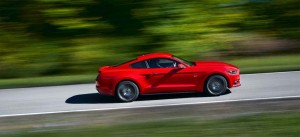
The 2015 Ford Mustang wil debut with a choice of three engines, including a new 2.3-liter I-4 EcoBoost.
The original model was an instant success – in fact, exceeding the automaker’s wildest expectations and forcing it to race to find ways to boost production. These days, Mustang doesn’t approach the volumes of some more mainstream passenger cars, such as the Ford Fusion, never mind the best-selling Toyota Camry. But it remains an iconic and visually distinctive product that provides a halo for the Ford brand.
And with fan clubs around the world, the maker is now hoping it will be able to take advantage of that to start marketing beyond North American shores in real numbers.
The new 2.3-liter inline-four EcoBoost engine, the latest member of that new turbocharged powertrain family, could give a boost to demand abroad, especially in markets like Europe where performance fans still have to cope with fuel costs of as much as $9 a gallon.
That new engine, developing an estimated 305 horsepower and 300 pound-feet of torque, could also appeal to Americans who want performance and fuel economy from the same vehicle.
“This EcoBoost engine delivers where a Mustang driver expects it to, with a broad, flat torque curve that pours out when you stand on it for easy passing or hustling down a twisty road,” said Dave Pericak, Ford Mustang chief engineer.
Of course, Ford isn’t walking away from its classic 5.0-liter V-8, and by adopting updates such as a new valvetrain and cylinder heads, the new Mustang GT will churn out a hefty 420 horsepower and 390 lb-ft.
The “base” Mustang won’t be a stone pony, the 3.7-liter V-6 rated at 300 horsepower and 270 lb-ft of torque. In fact, those would have been impressive numbers for a Mustang GT not that many years back.
Expect to see a variety of variants come to market over the long lifecycle of the new Mustang, including a convertible and a series of even more powerful performance models that could push the power envelope up to 600 hp and beyond before it’s time to move on to the seventh-generation pony car.
It will need all the muscle it can get. Mustang has been locked in an unusually fierce battle for dominance of the pony car segment ever since Chevrolet struck back with a reborn version of its Camaro — the General Motors coupe leading in the sales race repeatedly since Camaro’s return.
(Chevy wants to give Ford — and Porsche — a run for the money with the new Camaro Z28. Click Here for the details.)
Ford isn’t talking pricing yet but will likely nudge up the numbers, as it has on other models, when the 2015 Mustang reaches showrooms in time for the official 50th anniversary celebration next spring. The base car is hinted to come in somewhere around $25,000.

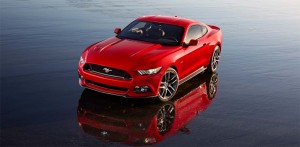
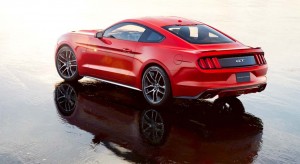
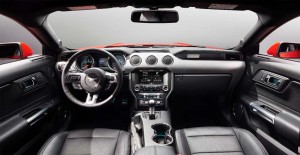
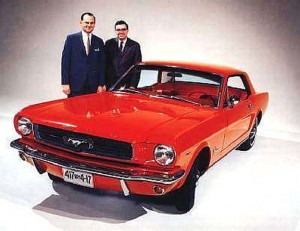
They definitely missed the mark on styling, IMO. It will still sell well because it’s a 50th anniversary model Mustang but they missed a golden opportunity.
I love the new Mustang. It is definitely the best looking Mustang I’ve ever laid eyes on…..except the back. I know it part of the old with the new…..I prefer the artist conception of some prelim designs with a horizontal bar back light instead of that trapezoidal looking ugly tail lamp that we’ve seen for the last 50 years……Enough already. So hope they have after market parts to allow consumers to customize it to suit their preference. Thanks for reading my post.